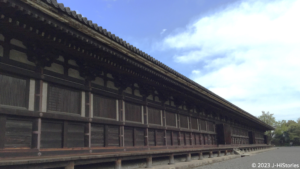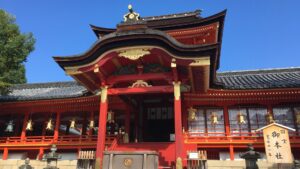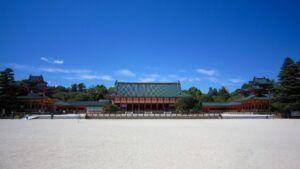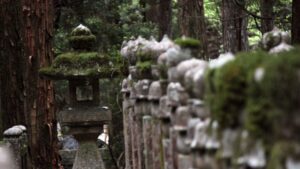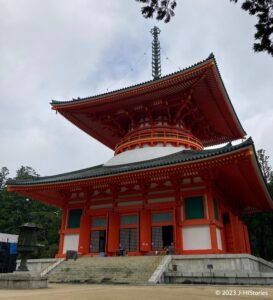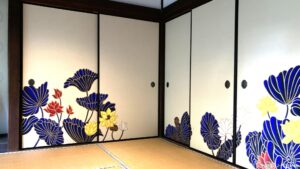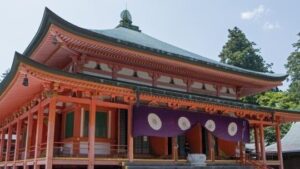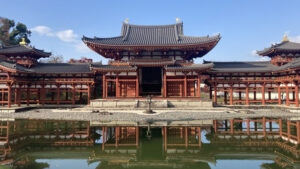Who Built Sanjusangen-do Hall and What does Sanjyusan mean?
The Sanjyusangen-do Hall (literally 33 intervals), officially Rengeoin Temple, resides in the heart of Kyoto. Constructed in 1164 by the retired Emperor Go-Shirakawa (1127~1192, 後白河天皇), or Go-Shirakawa-In, with the financial support of Samurai, Taira Kiyomori, to pray for the safety and prosperity of the nation and people. This remarkable 121-meter-long wooden structure features 33 spaced […]
Why did So Many Emperors, Court Nobles, and Samurai visit the Iwashimizu Hachimangu Shrine?
In the year 860, the Iwashimizu Hachimangu Shrine was established by an oracle who voiced a fervent wish to stand in proximity to the Imperial palace, safeguarding the nation. Thus, the venerated Hachiman deity was enshrined as a national guardian deity in Kyoto along the head shrine of Hachiman Okami, Usa Jingu Shrine in Kyushu. […]
Heian Jingu Shrine: When was Kyoto the capital of Japan?
Heian Jingu Shrine enshrines the spirits of the first and last emperors who governed the nation in Kyoto, the old capital of Japan, for over 1100 years, spanning from 794 to 1868. Passing through the vermilion Otorii gate, the Otenmon gate leads you into the interior of the Heian Jingu Shrine. The bright vermillion color […]
Koyasan Okunoin, Why are there so many gravestones?
One of the two most sacred sanctuaries at Koyasan is Okunoin. The Okunoin is believed the sanctuary where Maitreya Bodhisattva descends. The mausoleum where Kukai rests is located at the innermost part of the sanctuary. The 2-km approach from the Ichi-no-hashi bridge to Okunoin is lined with large cedar trees that are said to be […]
Aoi Matsuri Festival, the heart of Kyoto’s graceful festival at two Kamo Shrines
Aoi Matsuri is one of Kyoto's three most famous festivals (Aoi, Gion, and Jidai), held at Kamigamo and Shimogamo Shrines. It is also one of the three major Chokusai festivals (Aoi, Iwashimizu, and Kasugasai) where an imperial envoy delivers an invocation on behalf of the emperor for the safety of the nation and its people. The main […]
Koyasan, a mountain-top religious city of the Shingon Esoteric Buddhism
The Candle Festival is held on August 13th to pray for the spirits of all deceased at Koyasan - a World Heritage Site - located about 850 meters above sea level. Approximately one hundred thousand votive candles line the 2 km approach to Okunoin, surrounded by Japanese cedar trees, creating a solemn atmosphere in the […]
Shorenin Temple, Birth of Buddhism to Save the People
Shorenin Temple Kyoto sheltered and protected two persecuted Buddhists, Honen (1133-1212, 法然)and Shinran (1173-1263, 親鸞), from the Enryakuji Temple of the Tendai sect of Buddhism. Honen and Shinran were revolutionary figures in the Buddhist world whose teaching, later Japanese Pure Land Buddhism, was the chanting of the name of Amitabha Buddha single-mindedly towards enlightenment, trusting […]
Enryakuji Temple Enlightens the World for over 1200 years
Enryakuji on Mt. Hiei was founded by Saicho. Producing founders of several sects, it's called the "Mother of Japanese Buddhism." Enryakuji fought against three warlords: Oda Nobnaga, Shogun, and its retainer.
Byodoin Temple, Fujiwara Yorimichi's Aspiration for a Peaceful Death in the Pure Land of Buddhism
Byodoin Temple in Kyoto, the vermilion hue of the Phoenix Hall, golden-seated Amitabha Tathagata, many attractions. Fujiwara Yorimichi, the grand minister, built Byodoin Temple in 11C to wish the peacefule death in the pure land.
Daikakuji Temple, Noble Elegance In Every Corner. Imperial Court Culture began Here
Daikakuji is an unparalleled temple that offers a glimpse into the refined court culture of ancient times. Floating a boat on the pond, intoxicated by the sound of wind and string instruments, and admiring the moon. Why does Daikakuji exude such an indescribable elegance in every corner? The answer lies in its rich history - […]

